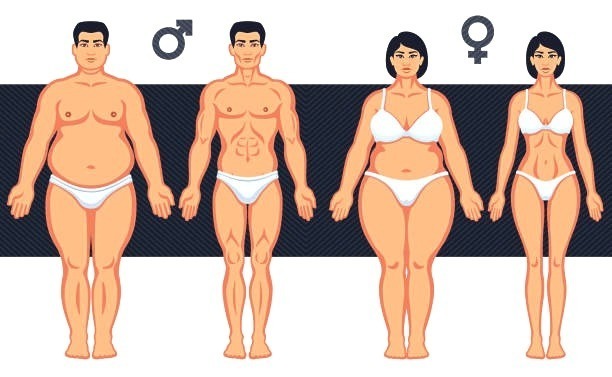The terms ‘weight loss and ‘fat loss’ are often used interchangeably by most people. Some use weight loss when they mean fat loss and vice versa.
To most people, these two terms mean the same thing but are they the same? Let’s dive deep into what they each mean and why knowing the differences can help you reach your fitness goal faster.
What Is Weight Loss?
When you check your weight on your scale, the number that you see is your weight loss and not fat loss. Your bathroom scale, and any other scale that only tracks your weight, measures your total body weight and nothing else.
When you weigh yourself in the morning before breakfast after your bowel movement, you will get your lowest reading of the day. This is because your body becomes dehydrated throughout the night.
You lose water through perspiration, and the lost fluids are usually never replenished until the following morning. Upon waking up, you empty your bowels, thus flushing away more water and waste matter so much so that you become a bit lighter.
After going for eight hours without any food during your sleep, your stored carbohydrates are usually very low. Carbohydrates usually hold water in your body, and because they are at their lowest in the morning, you’ll tend to weigh lighter.
If you check your weight at this point, you will be lighter because you’ve lost weight but not fat! Your body fat will still be intact while the weight of other substances such as glycogen, wastes, and water will usually be depleted.
What’s The Effect of Food and Drink on Your Weight
Now, begin your day and eat all your regular meals, drink water, and then weigh yourself again after dinner. You will be shocked that you may even weigh 2 kilos more. You will have gained weight plus a bit of fat in a single day.
This is another clear sign that weight loss and fat loss are two different things.
Knowing these differences is vital if you carry excess fat that you need to shed. So if you’re in such a position, set a goal to lose fat and not lose weight. It is the excess fat that makes you unhealthy and not the temporary daily weight gain.
Aim For Fat Loss, Not Weight Loss
Now here’s the most important point. Aiming to merely lose weight, can result in losing muscle tissue and putting on fat down the line.
The reason behind this is that the more muscle mass you have on your frame, the more you burn fat efficiently. Your muscle tissue is metabolically active, and it burns lots of calories to function normally.
Body fat, on the other hand, cannot burn calories on its own. So the less muscle mass you have, the fewer calories your body will burn. And the fewer calories your body burns, the more calories are stored as body fat.
So, shift your focus to fat loss and not merely losing weight.
The Process of Muscle Loss
How is it possible to lose muscle on a weight loss program?
I guess you’ve tried one or more diets in the past, or you’re currently on one now to lose weight. A majority of these diets demand a severe restriction of your calorie intake.
Every time you drastically cut your calories, your body signals to your mind that food is scarce. And because the body has an innate ability to store lots of fat for any impending food shortages or famine, it uses up your muscle for energy in your daily activities and during exercise but holds on to the fat.
The Problem With Very Low Carb Diets
Some diets such as Keto and Atkins recommends a severe carbohydrate restriction. Carbohydrates are your body’s first source of energy.
When your glycogen stores are depleted, your body turns to your protein (muscles) and body fat for energy. But since it’s not easy to break down fats to fuel your workouts, your body will preferentially burn muscle tissue.
Now, to make matters worse, a low carbohydrate intake signals the body to go into starvation mode again. This vicious cycle of your body eating into its muscle for fuel is set in motion again. You will therefore keep losing until after some time, you will have no muscle tone.
What About Cardio Workouts Weight Loss?
Alternatively, you might decide to lose weight by doing plenty of cardio exercises.
Reducing your total calorie intake and doing endless steady-state cardio without any form of resistance training is a terrible mistake. It will lead to loss of muscle tissue due to a sluggish metabolism.
Why is it that marathon runners are so skinny with no muscle tone?
It’s because the body can adapt and handle whatever stress you throw at it. When you run, swim or bike for long distances every week, your body adjusts and manages the stress and improves your endurance.
Guess what? Your muscles are heavier than fat, and for this reason, your body will shed more muscles when it wants to get lighter. In addition to muscle loss, you will also lose a bit of fat, but overall, you’ll lose more muscle than fat.
Why would you want to lose weight only to become a smaller version of yourself with the same body shape with no muscle tone?
Why would you want to be on a weight loss program that eats your muscles and lowers your fat-burning rate so much so that when you are off the program, the fat comes piling back on again?
The Solution?
Next time you’d like to get in shape, your focus must be to lose not just weight but to shed body fat and build lean muscle mass. To achieve this, you will need a combination of good nutrition, moderate cardio exercises and weight training to build and maintain muscle.
From now on, tell your friends that you are on a fat loss program and not a weight loss program. And that you are changing your eating habits instead of just simply starting a new diet.
With this clear distinction, you will know how to lose fat effectively, preserve and grow your muscles.
This is the best way to achieve your weight loss goal because you will only lose that which you need to get rid of… body fat.






